Related Research Articles
Chinese classic texts or canonical texts or simply dianji (典籍) refers to the Chinese texts which originated before the imperial unification by the Qin dynasty in 221 BC,particularly the "Four Books and Five Classics" of the Neo-Confucian tradition,themselves a customary abridgment of the "Thirteen Classics". All of these pre-Qin texts were written in classical Chinese. All three canons are collectively known as the classics.
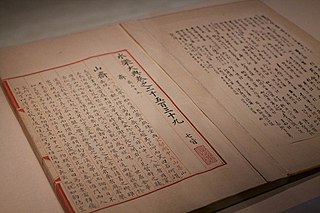
The Yongle Encyclopedia or Yongle Dadian is a largely-lost Chinese leishu encyclopedia commissioned by the Yongle Emperor of the Ming dynasty in 1403 and completed by 1408. It comprised 22,937 manuscript rolls or chapters,in 11,095 volumes. Fewer than 400 volumes survive today,comprising about 800 chapters (rolls),or 3.5 percent of the original work.

The Ming Xiaoling is the mausoleum of the Hongwu Emperor,the founder of the Ming dynasty. It lies at the southern foot of Purple Mountain,located east of the historical centre of Nanjing. Legend says that in order to prevent robbery of the tomb,13 identical processions of funeral troops started from 13 city gates to obscure the real burying site.
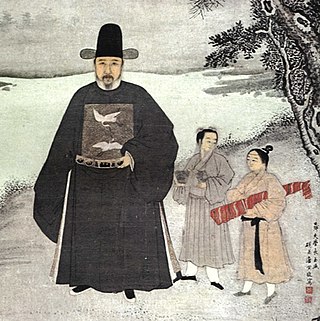
The scholar-officials,also known as literati,scholar-gentlemen or scholar-bureaucrats,were government officials and prestigious scholars in Chinese society,forming a distinct social class.

The Siku Quanshu,variously translated as the Complete Library in Four Sections,Imperial Collection of Four,Emperor's Four Treasuries,Complete Library in Four Branches of Literature or Complete Library of the Four Treasuries,was the largest collection of books in Chinese history with 36,381 volumes (册,Cè),79,337 volumes (卷,Juǎn),2.3 million pages and about 997 million words. The complete encyclopedia contains an annotated catalogue of 10,680 titles along with a compendiums of 3,593 titles. The Siku Quanshu ended up even longer than the Ming dynasty's Yongle Encyclopedia of 1403,which had been China's largest encyclopedia until then. A complete copy of the Siku Quanshu are held with each of the following:the National Library of China in Beijing,the National Palace Museum in Taipei,the Gansu Library in Lanzhou,and the Zhejiang Library in Hangzhou.
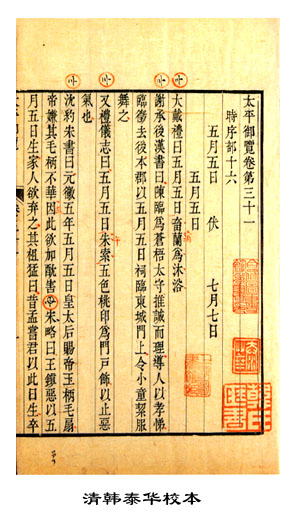
The Taiping Yulan,translated as the Imperial Reader or Readings of the Taiping Era,is a massive Chinese leishu encyclopedia compiled by a team of scholars from 977 to 983. It was commissioned by the imperial court of the Song dynasty during the first era of the reign of Emperor Taizong. It is divided into 1,000 volumes and 55 sections,which consisted of about 4.7 million Chinese characters. It included citations from about 2,579 different kinds of documents spanning from books,poetry,odes,proverbs,steles to miscellaneous works. After its completion,the Emperor Taizong is said to have finished reading it within a year,going through 3 volumes per day. It is considered one of the Four Great Books of Song.
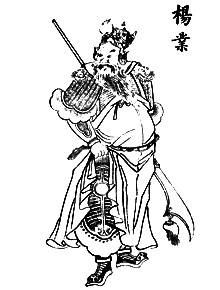
Yang Ye (楊業) or Yang Jiye (楊繼業),named Liu Jiye (劉繼業) before 979 and Yang Chonggui (楊重貴) in his youth,was a Chinese military general of the Northern Han and the Northern Song dynasties.

The leishu is a genre of reference books historically compiled in China and other East Asian countries. The term is generally translated as "encyclopedia",although the leishu are quite different from the modern notion of encyclopedia.
Canonical Book of the Tang Dynasty may refer to one of the two canonical history books about the Tang Dynasty:
The Tang Huiyao is an institutional history of the Tang dynasty compiled by Wang Pu and presented to Emperor Taizu of Song in 961. The book contains 100 volumes and 514 sections;it has an abundant content for the period before 846,and scarce material unobtainable from the Tongdian,Old Book of Tang,and New Book of Tang.
Dibao,literally "reports from the [official] residences",were a type of publications issued by central and local governments in imperial China,which was the only official government newspaper published by the ancient Chinese central government in different dynasties. 'Dibao' is a general term to describe the ancient Chinese gazette. Historically,there were different types of names used to describe Dibao in different dynasties among the imperial Chinese history. While closest in form and function to gazettes in the Western world,they have also been called "palace reports" or "imperial bulletins". Different sources place Dibao's first publication as early as the Han dynasty,which would make Dibao amongst the earliest newspapers in the world,or as late as the Tang dynasty according to the earliest verified and proved Dibao with historical relics. Dibao was continuously published among different imperial dynasties until the last imperial emperor in the Qing dynasty,Puyi,abdicated in 1912.

Chinese encyclopedias comprise both Chinese-language encyclopedias and foreign-language ones about China or Chinese topics. There is a type of native Chinese reference work called leishu that is sometimes translated as "encyclopedia",but although these collections of quotations from classic texts are expansively "encyclopedic",a leishu is more accurately described as a "compendium" or "anthology". The long history of Chinese encyclopedias began with the Huanglanleishu and continues with online encyclopedias such as the Baike Encyclopedia.
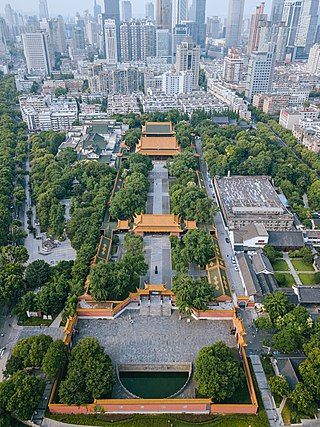
The Chaotian Palace,is located in Nanjing,China. It was built as an imperial palace in the Ming dynasty,and today it is known as the Nanjing Municipal Museum. Chaotian Palace area has the largest preserved traditional Chinese architectural complex in Jiangnan.
The History of Song or Song Shi is one of the official Chinese historical works known as the Twenty-Four Histories of China that records the history of the Song dynasty (960–1279). It was commissioned in 1343 and compiled under the direction of First Minister Toqto'a and Prime Minister Alutu during the Yuan dynasty (1271–1368) at the same time as the History of Liao and the History of Jin. Running to a total of 496 chapters,the History of Song includes biographies of the Song Emperors along with contemporary records and biographical sketches of Song dynasty politicians,soldiers and philosophers.

The Battle of Yancheng took place in 1140 near modern-day Luohe City in Henan Province,China between the main armies of China under the Song dynasty and the Jurchen Jin invaders from the north. The battle was a major clash in the wars between the Jin Empire and China. The Chinese forces,under the leadership of General Yue Fei,won a decisive victory despite being outnumbered.
Changzhou School of Thought was the Changzhou-centered influential school of scholarship that existed during the late Ming and Qing dynasties in China. Scholars of this school are best known for their contribution to the New Text Confucianism.
Wang Pu (王溥) (922–982) was a chancellor of imperial China's Later Zhou and Song Dynasty.
Wudai Huiyao is a Chinese historiography book on the Five Dynasties period of ancient China,written by the Song dynasty chancellor Wang Pu (922–982),who had personally served the last two of the five dynasties,namely the Later Han and the Later Zhou.
The Huanglan or Imperial Mirror was one of the oldest Chinese encyclopedias or leishu "classified dictionary". Cao Pi,the first emperor of the Wei,ordered its compilation upon his accession to the throne in 220 and it was completed in 222. The purpose of the Huanglan was to provide the emperor and ministers of state with conveniently arranged summaries of all that was known at the time. Complete versions of the Huanglan existed until the Song dynasty (960-1279),when it became a mostly lost work,although some fragments did survive in other encyclopedias and anthologies. The Huanglan was the prototype of the classified encyclopedia and served as a model for later ones such as the (624) Tang Yiwen Leiju and the (1408) Ming Yongle dadian.
Song Ruozhao was a Chinese Confucian scholar,poet and imperial official of the Tang dynasty (618–906). Her extant works include one poem,a short fiction story and her annotation to her sister's work:Analects for Women,a book about the proper roles and code of conduct for women,and a biography of Niu Yingzhen.
References
- (In Chinese) "Song Dynasty Manuscript Compendium" . Retrieved August 23, 2010.